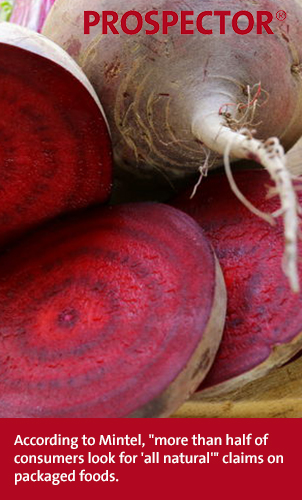 According to Mintel’s report, “Colors & Flavors: The Move to More Natural,” aware consumers are seeking out products with natural flavors and colors, and staying away from “unrecognizable” ingredients more often. Consumer perception has been leaning toward use of more identifiable ingredients. For example, a recent petition campaign in the U.S. urges the replacement of artificial colors with their natural alternatives in a popular macaroni and cheese dinner.
According to Mintel’s report, “Colors & Flavors: The Move to More Natural,” aware consumers are seeking out products with natural flavors and colors, and staying away from “unrecognizable” ingredients more often. Consumer perception has been leaning toward use of more identifiable ingredients. For example, a recent petition campaign in the U.S. urges the replacement of artificial colors with their natural alternatives in a popular macaroni and cheese dinner.
In fact, Mintel’s research tells us that “47% of US consumers prefer to eat foods without artificial additives,” and that “more than half of consumers look for ‘all natural'” claims on packaged foods. Natural colors (EU) lead in usage by new product developers over natural flavoring, with 77% growth from 2009 to 2013. Colors sourced from paprika (EU), beets (EU), and grape skins (EU) – with familiar ingredient origins – make consumers feel more comfortable with the ingredient listing.
But not every natural color is created equal in consumer perception – last year in the US, a yogurt manufacturer was criticized for using carmine (EU) (also known as conchineal extract) as a color in their products. Consumers are leaning toward a need to understand the source origin of an ingredient, which means that more familiar ingredient names will be more favorably received.
Read Mintel’s report on recent developments in natural colors and flavors and get more insights on this subject.
Colors & Flavors: The Move to More Natural (North America)
Colors & Flavors: The Move to More Natural (Europe)
The views, opinions and technical analyses presented here are those of the author or advertiser, and are not necessarily those of ULProspector.com or UL Solutions. The appearance of this content in the UL Prospector Knowledge Center does not constitute an endorsement by UL Solutions or its affiliates.
All content is subject to copyright and may not be reproduced without prior authorization from UL Solutions or the content author.
The content has been made available for informational and educational purposes only. While the editors of this site may verify the accuracy of its content from time to time, we assume no responsibility for errors made by the author, editorial staff or any other contributor.
UL Solutions does not make any representations or warranties with respect to the accuracy, applicability, fitness or completeness of the content. UL Solutions does not warrant the performance, effectiveness or applicability of sites listed or linked to in any content.


